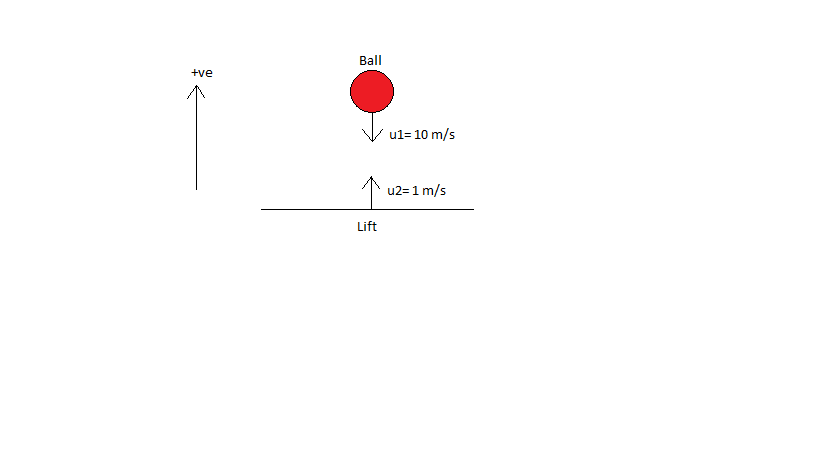Question
Question: A ball falls from a height such that it strikes the floor of lift at 10 m/s. If lift is moving in th...
A ball falls from a height such that it strikes the floor of lift at 10 m/s. If lift is moving in the upward direction with a velocity 1 m/s, then velocity with which the ball rebounds after elastic collision will be
A. 11 m/s
B. 10 m/s
C. 12 m/s
D. 9 m/s
Solution
Two particles are moving in the same direction in a straight line with velocities u1 and u2 respectively. Before the collision their velocity of approach will be (u1−u2)
After collision velocity of the first particle and second particle are v1 and v2 respectively. Therefore, velocity of separation will be (v2−v1).
Coefficient of restitution is the ratio of relative velocity of separation after collision to relative velocity of approach before collision.
Coefficient of restitution, e=u1−u2v2−v1
For, elastic collision, e=1.
Complete step by step answer:
Let us consider ball as particle 1 and lift as particle 2.
See the diagram before collision:

Taking upward direction as positive,
Velocity of ball before collision, u1=−10m/s
Velocity of lift before collision, u2=1m/s
Now, we should consider the situation after the collision.
After collision lift will continue it’s motion 1m/s upwards and the ball will rebound with a velocity, say v2 in upward direction.
So, Velocity of lift after collision, v2=1m/s
Velocity of ball after collision be v1m/s (let)
As it is an elastic collision, thene=1.
We know, e=u1−u2v2−v1
Now, putting the values,
1=−10−11−v1
⟹1−v1=−11
∴v1=11+1=12m/s
So, Ball rebounds with 12m/s velocity upwards after elastic collision.
So, the correct answer is “Option C”.
Note:
We can take e=1, when the collision is elastic. We can’t take e=1for inelastic or partially elastic collision. For, perfectly inelastic collision, e=0and for partially elastic collision 0<e<1.
